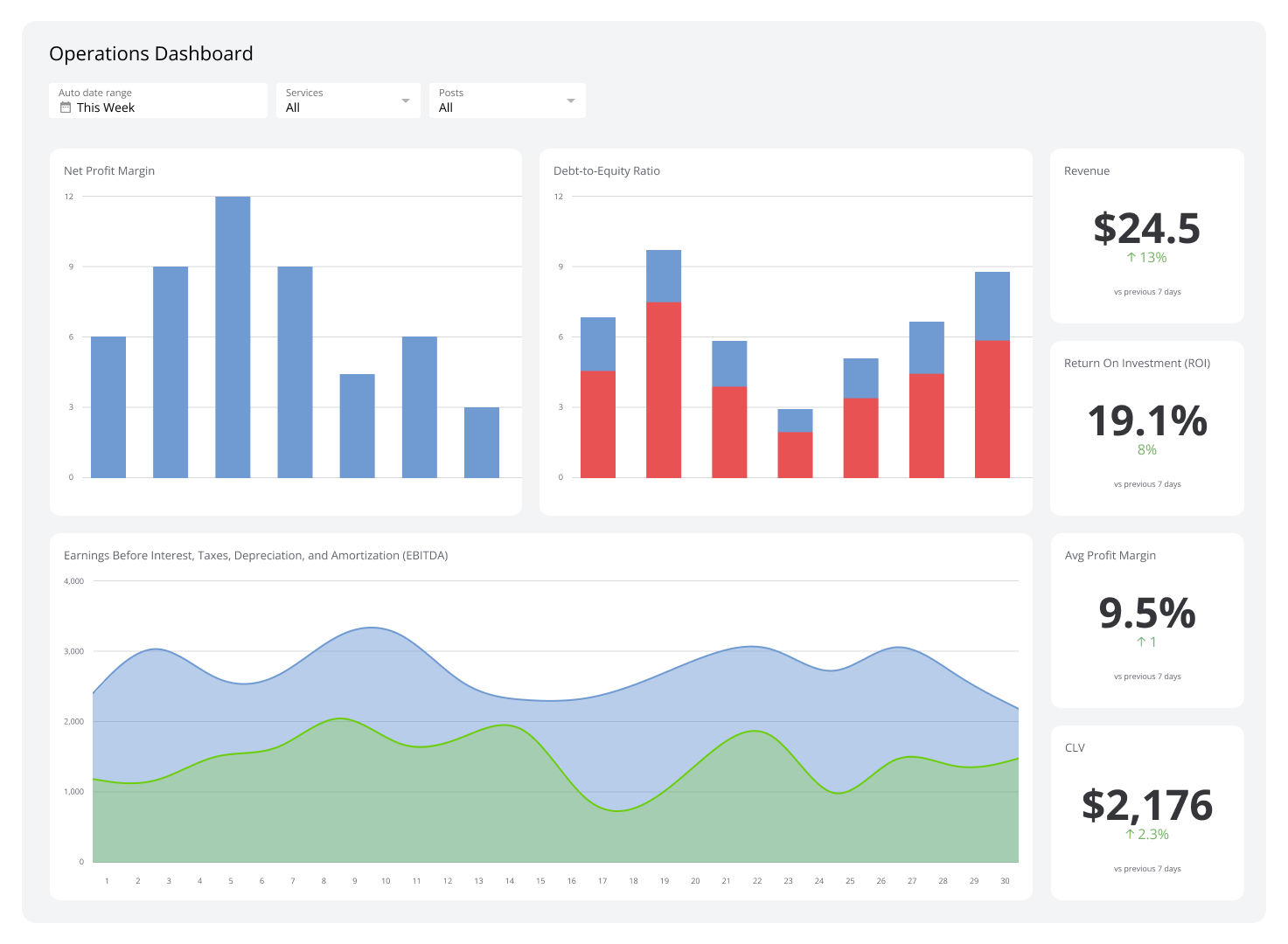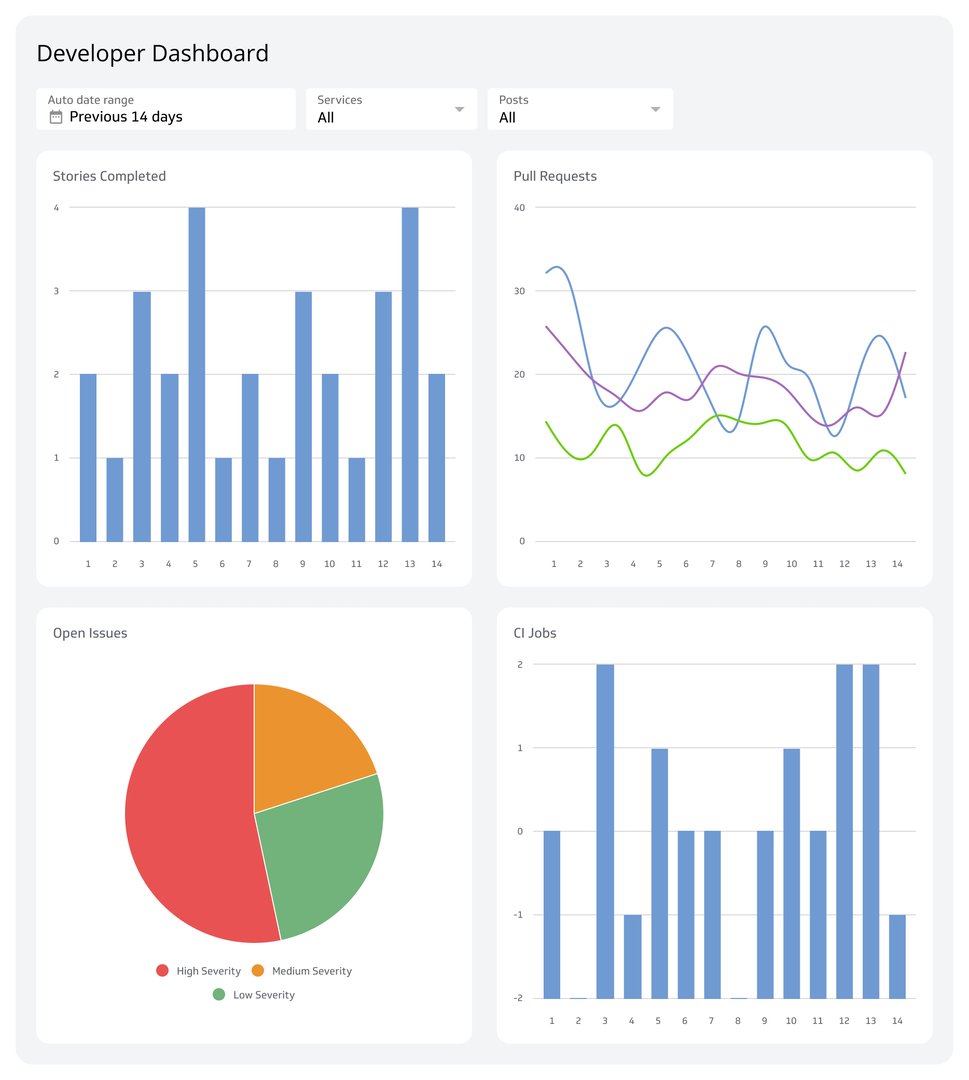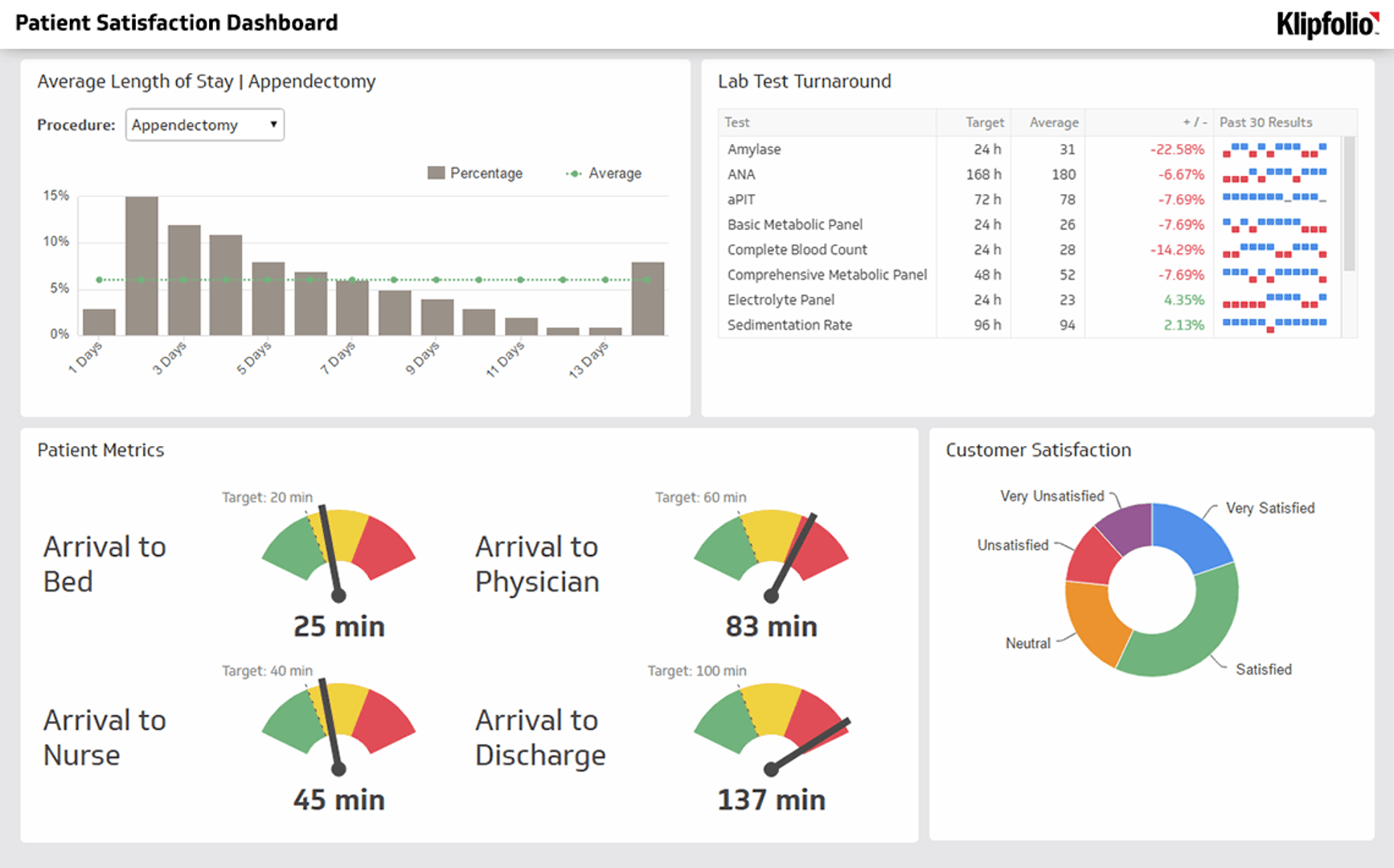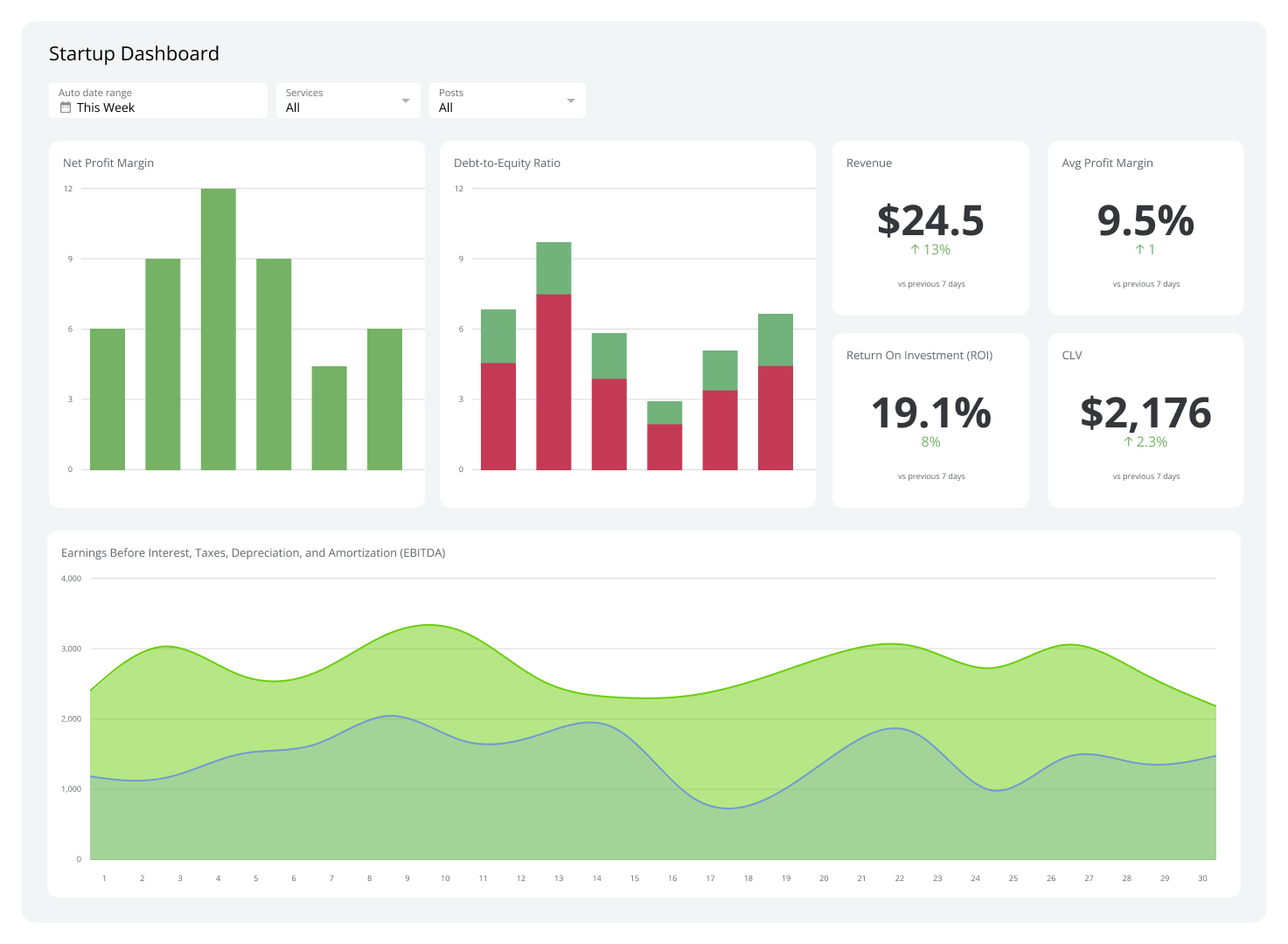Operations Dashboard
Operations dashboards help you monitor operations within specific business areas of your organization through easy-to-understand metrics and KPIs.
What is an Operations Dashboard?
An operational dashboard provides real-time views of operational metrics, allowing you to monitor, manage, and optimize your operations. It is designed to help you quickly discover work-related patterns, track performance, and make strategic decisions to simplify processes.
These dashboards assemble data from enterprise resource planning (ERP) and customer relationship management (CRM) platforms, databases, web sources, and AI.
They usually incorporate charts, graphs, and tables that show KPIs relevant to specific operational areas.
For instance, this dashboard could uncover machine production schedules and defect rates in a manufacturing setting.
Meanwhile, it could illuminate average response times and call volumes in a customer service environment to encourage resource allocation and service improvement.
Examples of Operations Dashboards
Management Dashboard
Management dashboards give you the ability to track project and team performance.
Designed for managers, they exhibit performance indicators to show how well resources are employed and whether goals are achieved. They also show financial metrics like revenue and profit margins and operational KPIs like turnover, production, and resource utilization rates.
Observing management dashboards can regularly help you identify issues like declining customer satisfaction scores. With this insight, you can make immediate quality improvements or service adjustments.
Who’s it for | Managers, team leaders, company executives, project managers, department heads |
How often it's needed | Daily, weekly, monthly, quarterly |
Covered KPIs | Revenue, average profit margins, budget vs. actual expenses, cash flow, production rates, resource utilization, cycle times, defect rates, sales growth, conversion rates, customer acquisition cost (CAC), average deal size, customer satisfaction scores (CSAT), net promoter score (NPS), churn rate, customer lifetime value (CLV), productivity rates, absenteeism, employee satisfaction, turnover rates, milestone completion rates, budget adherence, scope changes, risk indicators, progress towards strategic goals, balanced scorecards, competitive benchmarking, campaign effectiveness, lead generation rates, customer engagement, market penetration |
Finance Operations Dashboard
A finance operational dashboard shows your organization’s overall financial health by showing finance-related metrics like cash flow, expenses, and profitability. This gives you the necessary information to establish and execute financial strategies such as cost reduction initiatives and investment planning.
This dashboard also showcases accounts receivable and payable trends, letting you monitor liquidity, manage debt, and optimize working capital.
Who’s it for | Chief financial officers (CFOs), financial analysts, finance managers, company executives, accounting teams |
How often it's needed | Daily, weekly, monthly, quarterly |
Covered KPIs | Net profit margin, EBITDA, operating cash flow, accounts receivable turnover, accounts payable turnover, working capital, debt-to-equity ratio, current ratio, quick ratio, return on assets (ROA), return on equity (ROE), budget variance, cost of goods sold (COGS), gross profit margin, expense ratios, financial forecast accuracy, liquidity ratios |
IT Dashboard
An IT dashboard lets you view your IT infrastructure’s performance and security status with an IT dashboard. It focuses on metrics such as system uptime, network performance, and incident response times.
This dashboard also shows trends in IT resource utilization and security threats, letting you determine areas that demand optimization, potential vulnerabilities, and usage patterns.
With this information, you can quickly establish initiatives to maintain optimal performance and safeguard against threats. For example, you may work to upgrade infrastructure and enhance outdated or ineffective security protocols.
Who’s it for | Chief information officers (CIOs), IT managers, network administrators, cybersecurity teams, system analysts |
How often it's needed | Daily, weekly, monthly, quarterly |
Covered KPIs | System uptime, network latency, server response time, incident response time, number of security breaches, mean time to repair (MTTR), mean time between failures (MTBF), system and network availability, IT resource utilization, user satisfaction with IT services, number of helpdesk tickets, resolution rate, cost per incident, patch management status, compliance with IT policies, rate of successful backups, software and hardware inventory status |
HR Operations Dashboard
HR operational dashboards give you an overview of what’s driving your human resources strategy forward. They concentrate on crucial HR KPIs like employee turnover, hiring time, training effectiveness, expense per hire, recruitment efficiency, and workforce demographics.
Analyzing these performance indicators of this dashboard gives you a better understanding of the behind-the-scenes activities of your HR operations.
In addition, it will notify you of team and individual performance, allowing you to single out achievers and underperformers. Finally, it informs you of employee sentiment, making it easier to develop morale-boosting strategies.
Who’s it for | HR directors, HR managers, recruiters, talent development teams, company executives |
How often it's needed | Daily, weekly, monthly, quarterly |
Covered KPIs | Employee turnover rate, time to hire, cost per hire, employee engagement scores, training effectiveness, diversity metrics, headcount, absenteeism rate, employee satisfaction, performance appraisal scores, promotion rate, internal mobility rate, employee tenure, exit interview feedback insights, recruitment funnel metrics, offer acceptance rate, workforce productivity, benefit utilization, compliance with HR policies, talent retention rate |
OKR Dashboard
An OKR (objectives and key results) dashboard displays attainment metrics like objective completion rates, allowing you to visualize how far your company has progressed toward its goals. Moreover, it grants insight into how each team and department’s performance contributes to broader organizational goals.
Understanding this kind of operational dashboard will help you reallocate resources and adjust sales targets more effectively. You’ll also get to specify areas on track, goals requiring additional resources, and teams that are consistently exceeding their targets.
Who’s it for | Executives, department heads, team leaders, project managers, performance management teams |
How often it's needed | Daily, weekly, monthly, quarterly |
Covered KPIs | Goal completion rate, key result progress, alignment of OKRs with company strategy, performance against target timelines, team contribution to OKRs, cross-functional project progress, resource allocation efficiency, performance vs. stretch goals, milestone achievement rate, feedback and retrospective outcomes, impact on strategic initiatives, individual performance against OKRs, overall goal alignment score, rate of OKR updates and revisions, accountability metrics, departmental goal congruence, variance between planned and actual outcomes, success stories, challenges encountered |
Warehouse Dashboard
A warehouse dashboard provides a 360° glimpse at your warehousing operations. This dashboard’s metrics show your inventory levels and how they’re managed across different periods. They provide order fulfillment and stock management data, informing you of overstock potential, areas without stocks, fast-moving items, and inventory cycle changes.
With this data, it’ll become easier for you to find process inefficiencies that need to be addressed.
Who’s it for | Warehouse managers, inventory controllers, supply chain managers, logistics teams, company executives |
How often it's needed | Daily, weekly, monthly, quarterly |
Covered KPIs | Inventory turnover rate, perfect order rate, stockout rate, percentage of out of stock items, picking accuracy rate, order cycle time, average inventory levels, storage utilization, goods receiving time, goods dispatch time, rate of return, labor efficiency, shipment accuracy, back order rate, warehouse capacity, space utilization, inventory carrying cost, SKU (Stock Keeping Unit) performance, demand forecast accuracy, cost per order, on-time delivery rate, safety incident rate, transporting time, packing time |
Health and Safety Dashboard
Health and safety dashboards act as meters that let you gauge the success of your company's safety initiatives. These dashboards deliver metrics like incident rates, equipment inspection compliance, and the number of safety auctions. They also highlight trends in accident occurrences to inform you of high-risk areas and regions needing safety improvements.
Together, all this information makes it easier to establish better training programs, audits, and other measures to improve workplace safety. For example, it can track employee participation in safety training programs and calculate the efficacy of implemented safety measures.
Who’s it for | Safety officers, HR managers, operations managers, company executives, health and safety compliance teams |
How often it's needed | Daily, weekly, monthly, quarterly |
Covered KPIs | Incident rate, total recordable incident rate (TRIR), lost time injury frequency rate (LTIFR), near-miss frequency rate, severity rate, compliance rate, safety training completion rate, number of safety audits conducted, corrective action implementation rate, employee safety participation, days since last incident, equipment inspection compliance, emergency drill performance, safety observation and reporting rate, personal protective equipment (PPE) compliance, ergonomics assessment rate, mental health and well-being metrics, environmental safety metrics, safety-related absenteeism, root cause analysis completion rate, safety incident cost, chemical safety compliance |
Production Dashboard
A production dashboard provides real-time data on production volume, efficiency, yield, and defect rates. It highlights issues such as assembly line delays, spikes in defects, low inventory levels, or equipment failures.
By showing information on output, quality, efficiency, inventory, and equipment status, this dashboard helps managers make decisions, like reallocating resources or scheduling maintenance. These decisions can improve efficiency and increase both productivity and profitability.
Who’s it for | Production managers, floor supervisors, quality control teams, operations managers, company executives |
How often it's needed | Daily, weekly, monthly, quarterly |
Covered KPIs | Production volume, production efficiency rate, yield rate, defect rate, downtime rate, overall equipment effectiveness (OEE), cycle time, lead time, throughput, capacity utilization, scrap rate, rework rate, on-time delivery rate, inventory levels, machine utilization rate, maintenance schedule adherence, labor productivity, first pass yield, quality control metrics, setup time, energy consumption, safety incident rate on the production floor, cost per unit, order fulfillment rate, compliance with production standards, environmental impact metrics |
Wholesale and Retail Dashboard
A wholesale and retail dashboard reveals real-time sales data, inventory levels, and customer metrics. It highlights product performance, showing which items are selling well and which are underperforming.
It also warns of problems like stockouts of popular items, sudden drops in foot traffic, or unusual spikes in negative reviews.
This dashboard benefits businesses by allowing quick decision-making on pricing adjustments, inventory replenishment, marketing focus, and resource allocation across wholesale and retail operations. With the right data, it even lets managers promptly identify opportunities and address issues such as underperforming product lines or inefficient processes in your regional supply chain.
Who’s it for | Retail managers, wholesale managers, inventory managers, purchasing teams, company executives |
How often it's needed | Daily, weekly, monthly, quarterly |
Covered KPIs | Total amount sold, sales by region, sales by product category, inventory turnover rate, days sales of inventory (DSI), shrinkage rate, gross margin return on investment (GMROI), customer foot traffic, basket size, customer retention rate, sell-through rate, order fulfillment rate, stockout rate, inventory accuracy, seasonal inventory trends, sales per square foot, revenue per employee, discount and sales promotions effectiveness, supply chain costs, vendor performance, return rate, cross-channel sales effectiveness, e-commerce vs. in-store sales ratio, loyalty program success metrics |
SLA Dashboard
An SLA Dashboard displays metrics related to service level agreements between you and your customers. It typically uses color-coded indicators to underline areas meeting, approaching, or breaching SLA thresholds.
By providing a centralized view of SLA compliance, the dashboard facilitates proactive service quality management and helps you maintain strong customer relationships. Aside from that, it allows you to specify recurring issues and allot resources effectively to maintain or improve performance.
Who’s it for | Service managers, customer support teams, IT managers, company executives, operations managers |
How often it's needed | Daily, weekly, monthly, quarterly |
Covered KPIs | Incident resolution time, first response time, SLA compliance rate, CSAT, mean time to resolve (MTTR), mean time to acknowledge (MTTA), percentage of tickets reopened, on-hold time percentage, response accuracy, service availability, uptime percentage, downtime incidents, average handle time (AHT), customer complaints, escalation rate, backlog of unresolved issues, response time by priority level, resolution time by priority level, contract breach occurrences, service request volume, support team performance metrics, ticket closure rate, root cause analysis trends, service cost per ticket, customer effort score (CES) |
Customer Support Dashboard
Gain a total breakdown of your customer support measures with�
A customer support dashboard provides you with a total breakdown of your customer support measures through KPIs like first response time, average handling time, ticket backlog, and customer satisfaction scores. This lets you monitor your support team’s performance and identify bottlenecks.
On top of that, it provides insights into agent productivity, ticket priority distribution, and channel preferences.
Who’s it for | Customer support managers, team leads, agents, company executives, operations managers |
How often it's needed | Daily, hourly, weekly, monthly |
Covered KPIs | First response time, average handling time (AHT), customer satisfaction score (CSAT), net promoter score (NPS), ticket volume, ticket backlog, resolution rate, first contact resolution rate, average time to resolution, customer effort score (CES), agent productivity, ticket priority distribution, channel preference, self-service success rate, escalation rate, customer wait time, shopping carts abandoned, service level agreement (SLA) compliance, customer retention rate, knowledge base usage, agent utilization rate, customer feedback trends, recurring issue identification, cost per ticket, support channel efficiency, customer lifetime value (CLV), ticket reopening rate |
Get better data acquisition with operations dashboards
Operations dashboards give real-time updates on key metrics, pulling data from multiple sources to show how business processes are performing. They use visual tools to display KPIs, making it easier for your team to track progress and identify areas for improvement.
Klipfilio organizes all your essential operational metrics and KPIs in one place. Start your free trial today and simplify how you monitor operations.
Related Dashboards
View all dashboards



